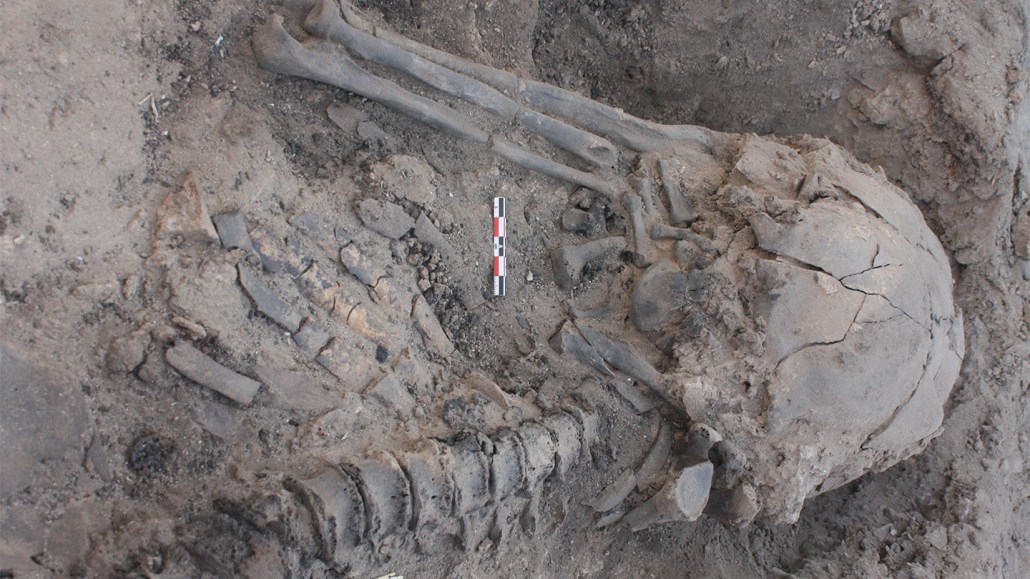A body burned inside a hut 20,000 years ago signaled shifting views of death
Linking the dead with human-built structures may have brought the dead and living closer

Charred remains of a woman (pictured) found amid burned remnants of a hut at a Jordanian site indicate that her dead body was placed there for an unusual burial event about 19,200 years ago.
L. Maher, D. Macdonald, EFAP Archive
Middle Eastern hunter-gatherers changed their relationship with the dead nearly 20,000 years ago. Clues to that spiritual shift come from the discovery of an ancient woman’s fiery burial in a hut at a seasonal campsite.
Burials of people in houses or other structures, as well as cremations, are thought to have originated in Neolithic-period farming villages in and around the Middle East no earlier than about 10,000 years ago. But those treatments of the dead appear to have had roots in long-standing practices of hunter-gatherers, says a team led by archaeologists Lisa Maher of the University of California, Berkeley and Danielle Macdonald of the University of Tulsa in Oklahoma.
The new find suggests that people started to associate the dead with particular structures at a time when groups of hunter-gatherers were camping for part of each year at a hunting and trading site in eastern Jordan. A budding desire to link the dead with human-built structures possibly reflected a belief that by doing so the dead would remain close to the living, the scientists report in the March Journal of Anthropological Archaeology.
Excavations at the ancient site, now called Kharaneh IV, in 2016 revealed a woman’s partial, charred skeleton on the floor of a hut that had been lit on fire. Her body had been placed on its side with knees flexed. Analyses of charring patterns on her bones and burned sediment surrounding her remains suggest the woman’s body was placed inside the hut just before the brushwood structure was intentionally burned. Charcoal- and ash-rich sediment borders where the hut once stood, a sign that the fire was confined to the structure. The hut’s walls apparently fell inward after being set ablaze.
Radiocarbon-dated samples from the earthen floor near the woman’s remains date her interment to around 19,200 years ago.
Several Neolithic sites contain examples of the dead having been placed in or under burned houses, as well as instances of bodies that were intentionally burned after death, says archaeologist Peter Akkermans of Leiden University, who did not participate in the new research. “The work at Kharaneh IV now dates these practices to more than 10,000 years earlier, in wholly different cultural settings of hunter-gatherer communities versus Neolithic farming villages.”
Other social developments traditionally attributed to Neolithic farmers, including year-round settlements (SN: 8/30/10) and pottery making (SN: 6/28/12), first appeared among hunter-gatherers.
Remains of at least three other huts have been found at Kharaneh IV, including one with graves beneath the floor that contained two human skeletons (SN: 2/22/12). That roughly 19,400-year-old hut was also burned down, possibly when the site’s occupants stopped using it but not as part of a human burial event.
The new discovery at Kharaneh IV “links the death of a person and the destruction or death of a building as part of a funerary rite,” Maher says. Perhaps the hut was where the woman or her family lived, or perhaps she died there and the structure was deemed off-limits, she suggests. Either way, Kharaneh IV was occupied for several generations after the woman’s death, until roughly 18,600 years ago, so establishing a permanent place for her may have been considered important.
Meanings and beliefs that Kharaneh IV residents attributed to burning a hut in which a dead woman’s body had been placed are still a mystery, Maher says. The use of fire in that event might have signified some type of transformation, rebirth, cleansing or life-and-death cycle, she suggests.







